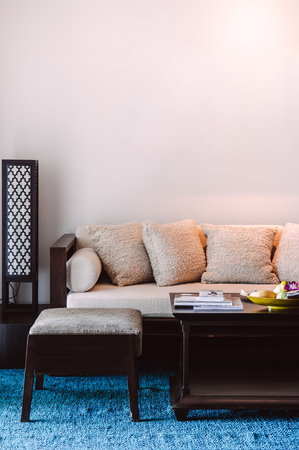Introduction: Why Texture Matters in American Living Rooms
When you step into a living room, what’s the first thing you notice? Often, it’s how the space feels—a sense of warmth, comfort, and balance that invites you to relax. In American homes, the living room is more than just a place to gather; it’s truly the heart of the home, where family and friends come together. Achieving that welcoming vibe goes beyond color schemes or furniture arrangements. The secret lies in balancing soft and hard textures, blending plush elements with structured materials to create an environment that feels both stylish and inviting. By thoughtfully combining cozy fabrics like cotton or velvet with natural woods, metals, or stone, you can elevate your living room’s design while ensuring it remains comfortable for everyday life. This harmony between soft and hard surfaces not only enhances visual interest but also reflects a lifestyle focused on comfort, sustainability, and mindful living—values that resonate deeply in many American households.
2. Soft Textures: Cozy Staples for Relaxed Living
When it comes to designing a harmonious living room, soft textures are key to creating a space that feels warm, inviting, and effortlessly comfortable. Americans love to relax and unwind at home, so it’s no surprise that plush furnishings have become staples in modern living rooms across the country. Whether you’re hosting friends for a movie night or curling up with a good book, these soft elements make your space feel like a true sanctuary.
Popular Soft Furnishings
The right soft furnishings can instantly transform the atmosphere of any room. Here are some favorites found in American homes:
| Soft Furnishing | Function | Design Tip |
|---|---|---|
| Plush Sofas | Main seating for relaxation and socializing | Choose neutral tones for timeless appeal, or go bold with eco-friendly fabrics in earthy hues. |
| Throw Blankets | Add warmth and texture; perfect for layering | Drape them over armrests or the back of the sofa for a relaxed look. |
| Area Rugs | Define zones and soften hard flooring | Select natural fibers like wool or jute to boost sustainability and comfort. |
| Pillows & Cushions | Offer extra support and visual interest | Mix sizes, shapes, and eco-conscious covers for an organic vibe. |
Creating an Inviting Atmosphere
The layering of these soft textures invites people to kick off their shoes and stay awhile. In many American households, oversized sectionals or deep-cushioned sofas are paired with cozy throws and pillows in varying fabrics—think organic cotton, recycled polyester, or linen blends. Large area rugs not only ground the furniture but also dampen sound, making open-plan spaces feel cozier and more intimate.
Sustainable Choices Matter
If you’re aiming for both comfort and conscious living, consider soft furnishings made from recycled or renewable materials. Eco-friendly options not only feel great but also align with the values of a growing number of American homeowners who prioritize green living. By thoughtfully selecting these cozy staples, you’ll create a balanced living room that’s as inviting as it is environmentally responsible.

3. Incorporating Hard Textures for Structure and Character
While soft textures set the stage for comfort, hard textures are essential for giving your living room structure and a distinctive personality. Hard elements like wood, stone, and metal act as anchors in your design, creating visual depth and grounding the overall aesthetic. For example, a solid wood coffee table serves as a central gathering point and adds warmth through its natural grain. Stone fireplaces not only provide a focal point but also infuse an organic, earthy feel that resonates with American home design traditions. Metal accents—whether in light fixtures, shelving brackets, or decorative objects—bring in a modern edge while reflecting light and adding subtle shine. By thoughtfully mixing these sturdy materials into your space, you introduce layers of interest that balance the plushness of fabrics and cushions. This mindful approach to texture creates a harmonious living room that feels both inviting and visually dynamic.
Mixing Materials: Practical Tips for a Balanced Look
Creating a harmonious living room starts with thoughtful material choices. The secret is to intentionally blend soft and hard textures, making the space feel inviting and comfortably lived-in. Here are some easy ideas to help you achieve the perfect balance between plush, cozy elements and sleek, sturdy surfaces.
Layer Soft Textiles Over Hard Foundations
Softer fabrics—think cotton throws, velvet pillows, or wool rugs—instantly warm up solid pieces like leather sofas or wooden coffee tables. Layering these materials adds depth and visual interest without overwhelming the room. For instance, drape a chunky knit blanket over an angular armchair or place a woven rug under a glass-top table to soften its look.
Mix and Match Finishes
Combine different finishes to keep the room from feeling too uniform or cold. Pair matte ceramics with glossy lacquer trays, or set up a reclaimed wood bench alongside smooth metal accents. This interplay of textures makes the environment feel personal and thoughtfully designed.
Quick Reference Table: Soft vs. Hard Material Ideas
| Soft Textures | Hard Textures |
|---|---|
| Linen curtains | Stone fireplace surround |
| Cotton slipcovers | Glass coffee table |
| Shaggy area rugs | Metal floor lamp |
| Corduroy poufs | Wooden bookshelf |
Balance Proportions for Everyday Comfort
If your living room has a lot of exposed brick or tile, soften the effect with oversized cushions or plush ottomans. Conversely, add structure to rooms dominated by textiles with sculptural decor like ceramic vases or steel side tables. The goal is not symmetry but a sense of visual equilibrium that feels easy-going and fresh.
Pro Tip: Use Nature-Inspired Accents
Incorporate sustainable elements like bamboo trays, rattan baskets, or potted plants for an eco-friendly touch. These pieces bridge the gap between soft and hard while staying true to a natural design vibe—perfect for American homes that value relaxed comfort and environmental mindfulness.
5. Eco-Friendly Choices: Sustainable Materials and Designs
When striving for a harmonious balance between soft and hard textures in your living room, sustainability can easily be woven into your design choices. Opting for eco-friendly materials doesn’t mean sacrificing comfort or style—in fact, it often adds warmth, authenticity, and peace of mind to your space. Consider the following tips as you blend environmental responsibility with inviting, tactile diversity:
Selecting Natural Fibers for Softness
Incorporate textiles like organic cotton, linen, bamboo, or wool for your cushions, throws, and area rugs. These natural fibers are not only gentle to the touch but also produced with fewer chemicals and less water. Look for products labeled with certifications such as GOTS (Global Organic Textile Standard) to ensure ethical sourcing.
Choosing Recycled or Upcycled Elements
Hard surfaces can also be eco-conscious. Seek out furniture made from reclaimed wood, recycled glass, or metal salvaged from previous uses. These materials provide visual texture and character while reducing waste and minimizing your carbon footprint.
Sustainable Upholstery and Filling
For seating and accent pillows, consider options filled with recycled polyester or natural latex instead of conventional foam. Upholstery made from hemp or recycled fabric blends delivers both durability and planet-friendly appeal.
Finishing Touches That Matter
Round out your space with accessories crafted from sustainable sources—think jute baskets, seagrass planters, or ceramic vases made by local artisans. By intentionally selecting decor that is both eco-friendly and tactilely interesting, you create a living room that’s as kind to the environment as it is comfortable for you and your guests.
6. Bringing It All Together: Creating a Cohesive Space
Once you’ve chosen your favorite mix of soft and hard textures, it’s time to bring everything together for a harmonious living room that feels both welcoming and distinctly American. Start by arranging your main furniture pieces—like a classic leather sofa or a cozy upholstered sectional—so they anchor the space and invite conversation. Layer in soft elements such as throw pillows, knit blankets, or a tufted ottoman to introduce warmth and comfort. To create that signature American vibe, blend in natural materials like reclaimed wood coffee tables, stone accents, or woven baskets for storage. Don’t forget the details: add a textured area rug underfoot, incorporate metal or ceramic lamps for contrast, and hang art that reflects local culture or landscapes. Balance is all about mixing these textures evenly throughout the room; avoid clustering too many hard or soft surfaces in one area. Instead, distribute them so each corner feels thoughtfully curated. Finally, personalize your space with eco-friendly touches—think vintage finds from local flea markets or sustainable décor made by American artisans. By layering diverse textures mindfully, you’ll achieve a living room that’s not only visually balanced but also brimming with comfort and character—a true reflection of American home style.


